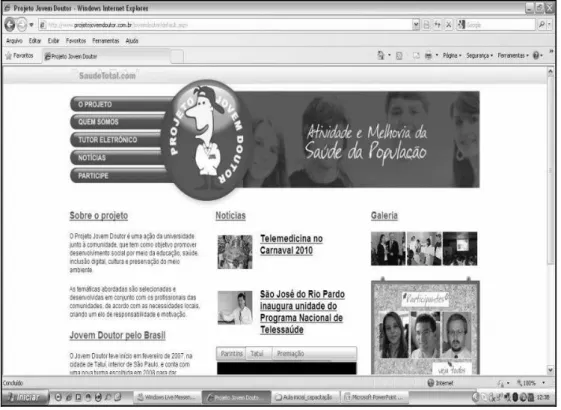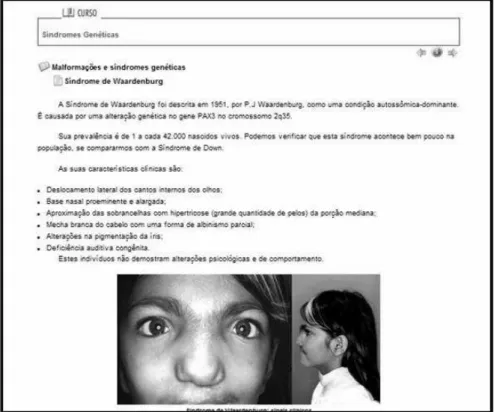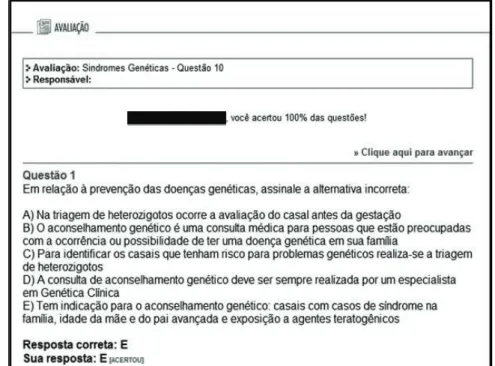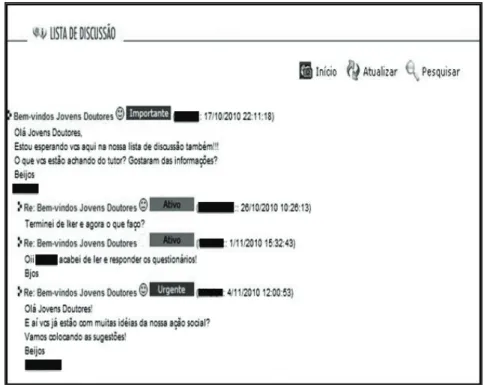THE DEVELOPMENT OF A VIRTUAL LEARNING
ENVIRONMENT IN GENETIC SYNDROMES
A elaboração de um ambiente virtual de aprendizagem
em síndromes genéticas
Mirela Machado Picolini(1), Wanderléia Quinhoeiro Blasca(2),
Antonio Richieri-Costa(3), Luciana Paula Maximino(4)
(1) MSc, Speech-Language Pathologist and Audiologist;
Gra-duated by the Bauru School of Dentistry, University of São Paulo – FOB/USP. Bauru, São Paulo – Brazil.
(2) MSc, PhD, Speech-Language Pathologist and Audiologist;
Professor Assistant of the Speech-Language and Hearing Department of the Bauru School of Dentistry, University of São Paulo – FOB/USP. Bauru, São Paulo – Brazil.
(3) MD, PhD, Geneticist at the Hospital for Rehabilitation of
Craniofacial Anomalies of the University of São Paulo – HRAC/USP, Bauru, SP, Brazil; Full Professor in Genetics at the School of Medicine of Ribeirão Preto – USP.
(4) MSc, PhD, Speech-Language Pathologist and Audiologist;
Professor Assistant of the Speech Language and Hearing Department of the Bauru School of Dentistry, University of São Paulo – FOB/USP. Bauru, São Paulo – Brazil; Doc-tor in Biological Sciences in Medical and Human Genetics Area at the Bioscience Institute of the State University of São Paulo.
Foster source: São Paulo Research Foundation - FAPESP.
Conlict of interest: non-existent
in Speech-Language Pathology and Hearing was regulated by the Federal Counsel of Speech-Language Pathology and Hearing, according to the resolution no 366/2009, deining as “profession exer
-cise by means of the technologies of information and communication using interactive methodolo-gies and virtual environments of learning which may assist, promote education and realize researches in health”1.
One of the aspects of large expansion of
Telehealth in Speech-Language Pathology and Hearing sciences are the development and conso-lidation of projects that approaches Teleducation.
The terms “Distance Education” and “Teleducation”
are frequently used as synonyms. However, Teleducation must be seen as an optimization of process, in an environment that combines
technolo-gies to improve the educational eficacy, of both the
traditional methods and the distance courses2.
Several studies of health education associated to TICs are being developed in Speech-Language Pathology and Hearing area, embracing education activities to the professional3-5, to the patient6-7 and
to population in general8-10. Speciically related to
INTRODUCTION
Telehealth is the offer of health services in situ-ations with physical and/or temporal distance, by means of using technologies of information and communication (TICs). The practice of Telehealth
ABSTRACT
Purpose: to develop a virtual learning environment (VLE) for elementary school students about genetic syndromes. Method: VLE, known as Cybertutor enables student learning through the Internet interactively. The methodology of this study consisted of two stages, the development and availability of the VLE. The development of educational content, graphic and audiovisual Cybertutor’s counted
on the help of a geneticist at the HRAC/USP and scientiic information available in books, articles,
thesis and national and international dissertations. The Cybertutor was available on the platform of the Young Doctor Project (http://www.jovemdoutor.org.br/jdr/) by the technical staff of DTM/FMUSP. Results: elaborated Cybertutor enabled the structure of educational content, graphics and audiovisual topics, to insert reinforcing issues, mailing list and check the performance of students. Conclusion: the VLE developed can be an important tool for health education in Genetic Syndromes, covering various regions of the country.
deinition of the approached topics, was made a
survey supported by a geneticist of the Hospital for Rehabilitation of Craniofacial Anomalies, University of São Paulo (HRAC/USP). Therefore, was opted to choose few genetic syndromes with different
etio-logic classiications (chromosomal disorders, gene
mutations, multifactorial and craniosynostosis). The primary sources of information was consti-tuted on books, articles of national and international periodic and information available on web, since originated of sites of educational institutions and dissertations and theses available online.
From the detailed analysis of selected informa-tion, a script was developed in Microsoft® Ofice
Word 2007 with the educational content of the Cybertutor.
Also were selected the contents of graphic (illus-trative images) and audiovisual related to theme. It is important to emphasize that the language used in content, was appropriated to comprehension of elementary students.
As shown in Figure 1, the Cybertutor named
“Genetic Syndromes” was didactically divided in
topics.
2nd Stage – Availability of VLE
The technic team of the DTM/FMUSP, consti-tuted by designers, web designers, journalists and communicators, was responsible for the insertion on web of the educational, graphic and audiovisual content.
The Cybertutor was available on platform of the Young Doctor Project (Figure 2), been accessed by the following address: http://www.jovemdoutor.org. br/jdr/.
RESULTS
To accomplish the access to educational content
of Cybertutor, irst it was need the student fulilled
an individual login in the platform of Young Doctor Project. The tutor should authorized the login and allow the access. Thus, the educational content
would be available through identiication (e-mail
address) and password (Figure 3).
genetics syndromes, still are deicient in national
literature and international studies that regards this theme.
It is up to the Speech-Language Pathologist and Audiologist, as member of the multidisciplinary team, and to the professional of public health, develop programs and educational practices that involve the promoting, prevention and rehabilitation of health11.
Concerning the genetic syndromes these practices also applied, since the DataSUS data show that in the period of 2005 to 2008, there were a total of 11,806.180 live-born and 75,814 of these patients had a genetic abnormality12.
Based on the above, the objective of this study was to develop a virtual learning environment (VLE) approaching the genetic syndromes theme for elementary students.
METHOD
This project consists of a dissertation, resulting in the development of a VLE known as Cybertutor.
The Cybertutor on web, or electronic tutor, enables student learning by internet interactively,
allowing veriication of the performance by both the
student and the tutors (leaders). Also presents inte-ractivity resources, as the forum and the discussion
list which ensure a better proximity between tutor
and students.
The methodology of this study was composed by two stages: the developing and availability of VLE, gathering a set of procedures; and information creation.
It is stressed that this study was developed through a partnership between the Department of Speech-Language and Hearing, Bauru School of Dentistry – University of São Paulo (FOB /USP) and the Discipline of Telemedicine, School of Medicine, University of São Paulo (DTM-FMUSP).
The approval is iled in the Ethics Committee in
Research at FOB / USP under protocol no 039/2009.
1st Stage – Development of VLE
The development of a VLE named “Genetic Syndromes” leads us to ininite possibilities in
GENETIC
What is genetics?
What is medical genetics? What is gene?
What does gene do?
Curiosities: advances in genetic and genome project. Mutation
GENETIC
DISORDERS/AFFECTIONS
monogenic disorders chromosomal disorders multifactorial disorders mitochondrial disorders
GENETICS MALFORMATION AND SYNDROMES
What is malformation? Cleft lip and palate What is a syndrome? Down Syndrome
Waardenburg Syndrome Achondroplasia
Velocardiofacial Syndrome The Fragile X Syndrome Albinism
Duchenne Muscular Dystrophy
Craniossinostosis: Apert Syndrome and Crouzon Syndrome
PREVENTION OF GENETICS DISEASES
Genetic advice Heterozygous Trial Consanguinity
Advanced maternal age Environmental Factors Medicines
Smoking Alcohol
Acid folic intake
THE IMPAIRED PATIENT AND SOCIETY
Students with special educational needs and school – School Inclusion
The Student inclusion and legislation
The contents educational, graphic (illustra-tive images) and audiovisual were available in The chosen media, the Cybertutor, enabled
structured the theoretical content in topics, as the
Figure 2 – Young Doctor Project Platform (partial illustration)
Figure 4 – Index Page of Cybertutorof “Genetics Syndromes” (partial illustration)
the learning. The student only went to the next
topic answering correctly of the question (Figure 6), otherwise, went back to the topic to remake the content reading (Figure 7).
Aiming to ensure and monitor the students lear-ning was created 16 questions of reinforcement along the educational content of Cybertutor. The reinforcement questions enabled the tutor to monitor
The Cybertutor also allowed the tutor verify the
performance and access of students. The igures 9
demonstrated this tool. The discussion list is an interactive tool
asyn-chronous created to allow the exchange of infor -mation, doubts and questions, as demonstrated in
igures 8. The discussion list was a strategy used to
maintain the interaction between tutor and student.
Figure 9 – CybertutorScreen– Performance Veriication (partial illustration)
The discussion list of guarantees the
interac-tivity and exchange of information (igure 8). This
tool allows comprehending the thought of other
people, construct and express ideas and stimulate
arguing15. Several studies8,9,13,14,16, also used the
discussion list to maintain the interaction and moti-vation of students in VLE.
The Cybertutor, as VLE interactive, also was used in other projects, verifying that it demonstrate
to be an excellent option to knowledge acquisition,
therefore, corroborating to this study3,8,9,13,14,16,17.
CONCLUSION
The VLE developed provides the union of infor-mation to technology and resources of interacti-vity, available on web. So, it is assumed that this Cybertutor can be an important tool of health educa-tion in Genetic Syndromes, enclosing the most diffe-rent regions of country.
ACKNOWLEDGEMENTS
To Telemedicine Team of FMUSP and to São Paulo Research Foundation (FAPESP – process no
2009/03362-5), that enables the execution of this
study.
DISCUSSION
The development of a VLE adds TICs to process of teaching/learning. The VLE, known as Cybertutor was initially developed by DTM/FMUSP. Nowadays, several thematic are being developed by researches of the Teleducation area. Develop an educational material is a challenger task and create a material that provides learning, in a pleasant and interactive
manner, is even more complex7. In this study
speci-ically, were several challenges, since the adequacy
of the technical language, to images polishment, to the choice of the themes more motivating and appropriated to thematic of tutor.
Because it is a VLE available on Internet, the
access hours are lexible, due to the time and inte -rest availability. Another study13, which also used
the VLE, veriied that this pattern of education
promotes the learning in educational content thema-tics, in digital inclusion and in self-discipline.
The Cybertutor enables the fragmentation of
educational content in topics (igure1, igure 4 and igure 5), making easier the direction of learning.
As shown in igures 6 and 7, the reinforcement
questions allowed tutor a better monitoring of lear-ning. A different study14, also inserted reinforce-ment questions in a VLE, aiming to improve the memorization and learning of content.
RESUMO
Objetivo: desenvolver um ambiente virtual de aprendizagem (AVA) para alunos do ensino fundamen-tal sobre síndromes genéticas. Método: o AVA, conhecido como Cybertutor, possibilita o aprendizado do aluno pela internet de forma interativa. A metodologia deste estudo foi composta de duas etapas, a de desenvolvimento e a de disponibilização do AVA. O desenvolvimento do conteúdo educacional,
gráico e audiovisual do Cybertutor contou com o auxílio de um geneticista do HRAC/USP e de infor
-mações cientíicas disponibilizadas em livros, artigos, teses e dissertações nacionais e internacionais.
O Cybertutor foi disponibilizado na plataforma do Projeto Jovem Doutor (http://www.jovemdoutor.
org.br/jdr/) pela equipe técnica da DTM/FMUSP. Resultados: o Cybertutor elaboradopossibilitou
estruturar o conteúdo educacional, gráico e audiovisual em tópicos, inserir questões de reforço, lista de discussão e veriicar o desempenho dos alunos. Conclusão: o AVA desenvolvido pode ser uma importante ferramenta de educação em saúde em Síndromes Genéticas, abrangendo as mais diver-sas regiões do país.
9. Picolini MM, Campos K, Oliveira JRM, Maximino
LP, Blasca WQ. Prevenção e promoção da saúde auditiva: o projeto jovem doutor na formação de agentes multiplicadores. In: Anais do IV Seminário
cientíico de políticas públicas, serviços e sistemas
em saúde auditiva; 2010; Bauru SP. Bauru; 2010.
10. Spinardi ACP, Blasca WQ, Wen CL, Maximino
LP. Telefonoaudiologia: ciência e tecnologia em saúde. Pro Fono. 2009; 21(3):249-54.
11. Moreira MD, Mota HB. Os caminhos da fonoaudiologia no sistema único de saúde – SUS. Rev CEFAC. 2009; 11(3):516-21.
12. MINISTÉRIO DA SAÚDE. Departamento de Informática do SUS [homepage na internet] [acesso em 16 de maio de 2011]. Disponível em: http://
tabnet.datasus.gov.br/cgi/tabcgi.exe?sinasc/cnv/
nvuf.def
13. Sequeira E. Aplicação de modelo educacional interativo como recurso para orientação e motivação sobre saúde oral em idosos [tese]. São Paulo (SP): Faculdade de Medicina da Universidade de São Paulo; 2009.
14. Paixão MP, Miot HA, Souza PE, Haddad AE, Wen CL. A university extension course in leprosy:
telemedicine in the Amazon for primary telehealth. J Telemed Telecare. 2009; 15(6):64-7.
15. Wen CL, Silveira PSP, Azevedo RS, Böhm GM. Internet discussion lists as an educational tool. J Telemed Telecare. 2000; 6(5):302-4
16. Corrêa FG. Treinamento de proissionais de
educação física para o reconhecimento precoce de doenças osteoarticulares através do uso de teleducação interativa [dissertação]. São Paulo (SP): Faculdade de Medicina da Universidade de São Paulo; 2008.
17. Soirefmann M, Boza JC, Comparin C, Cestari TF, Wen CL. Cybertutor: um objeto de ensino
na Dermatologia. An Bras Dermatol [periódico na
Internet]. 2010; 85(3):400-2.
REFERENCES
1. CFFa – Conselho Federal de Fonoaudiologia [homepage na internet]. Resolução nº 366, de 25 de abril de 2009. Dispõe sobre a regulamentação do uso do sistema Telessaúde em Fonoaudiologia. [acesso em 18 de julho de 2009]. Disponível em http://www.fonoaudiologia.org.br/legislacaoPDF/ Res%2036609%20Telessaude.pdf
2. Spinardi ACP, Blasca WQ, De-Vitto LM. Genética e fonoaudiologia: aprendizado baseado na teleducação. Pro Fono. 2008; 20(Supl):42-4.
3. Blasca WQ, Maximino LP, Galdino DG, Campos
K, Picolini MM. Novas tecnologias educacionais no ensino da Audiologia. Rev CEFAC. 2010; 12(6):1017-24.
4. Melo TM, Alvarenga KF, Blasca WQ, Taga MFL. Opinião dos agentes comunitários de saúde sobre o uso da videoconferência na capacitação em saúde auditiva infantil. Rev CEFAC. 2011; 13(4):692-7. 5. Ferrari DV, Blasca WQ, Bastos BG, Bevilacqua
MC, Wen CL. Teleaudiología: deiniciones y SUS aplicaciones en Brasil [jornal na internet]. Asociación
Argentina de Audiología, Buenos Aires. 2008 maio 31[acesso em 18 de fevereiro de 2009]. Disponível em: http://www.asara.org.ar/sec_audclin_art2.asp 6. Bastos BG, Ferrari DV. Internet e educação ao paciente. Arq Int Otorrinolaringol. 2011; 15(4):515-22.
7. Campos K, Oliveira JM, Blasca WQ. Processo
de adaptação de aparelho de ampliicação sonora individual: elaboração de um DVD para auxiliar
a orientação a indivíduos idosos. Rev Soc Bras Fonoaudiol. 2010; 15(1):19-25.
8. Macéa DD, Rondon S, Chaar LJ, Wen CL. Public health education for young students aided by technology. J Telemed Telecare. 2009; 15:159.
http://dx.doi.org/10.1590/S1516-18462013005000003
Received on: November 25, 2011 Accepted on: February 07, 2012
Mailing Address: Mirela Machado Picolini 32 São Benedito Street Araçatuba, São Paulo, Brazil Zip Cod: 16072-080



